Day 1: A royal welcome for the king and queen of Tonga
In keeping with island traditions, the Polynesian Cultural Center always planned to hold a “grand reopening” celebration for its recently renovated Tongan Village on June 11, 2016; but then the king and queen of Tonga — His Majesty King Tupou VI, King of Tonga, and his wife, Her Majesty Queen Nanasipau’u — accepted an invitation to attend the event, and customary Polynesian protocol rose to much higher levels.
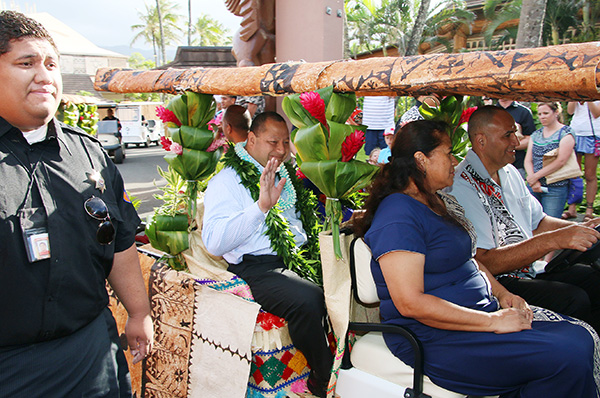
(Right – left): PCC Presiden & CEO Alfred Grace and his wife, Valerie, escort His Majesty King Tupou VI of Tonga and his wife, Queen Nanasipau’u (not visible) to the banquet in their honor. (PCC photos by Mike Foley)
Upon arriving at the PCC gate near the Hamana Kalili statue the afternoon of June 10, the Hawaiian Villagers at the Center heralded the royal couple’s arrival with seashell trumpets, drums and chanting. PCC President & CEO Alfred Grace and his wife, Valerie, greeted the royal couple and presented the customary flower leis. The Hawaiians performed an ancient-style hula kahiko; and then the royals and the Graces boarded a specially decorated electric cart and proceeded through two long lines of PCC employees, service missionary volunteers and lucky guests to the nearby Samoan Village activities.
The welcoming banquet had been set up in the large Samoan fale (house), because the Tongan Village was still being prepped for the reopening program the next morning. In keeping with Tongan tradition, PCC Physical Facilities staff had erected a temporary, raised throne-like dais for the king and queen and hung a large Tongan coat of arms crest at the back.
Meanwhile, all the other invited guests and members of the royal entourage had already taken their seats at the banquet. The king’s entourage included the Hon. Semisi Sika, Minister of Tourism and Infrastructure, who is also a BYU–Hawaii and PCC alumnus; the Hon. Tupouahomee Tuita, Cultural Director; Gary Pasina Lavaki, a cultural consultant and PCC alumnus; Mr. Motu’apuaka, his majesty’s talking chief; Mrs. Viela Tupou, Lord Chamberlain and private secretary; Siaosi Kaho, ADC; Siale Puloka, Assistant Secretary, Palace Office; and Ms. Palolo Uata and Ms. Ilaisaane Loloa, Personal Assistants.
The Church of Jesus Christ of Latter-day Saints, which founded the PCC in 1963 to help preserve and portray finer aspects of Polynesian culture and provide jobs for students at the adjoining Brigham Young University Hawaii, sent Elder Dale G. Renlund of the Twelve to address them at a banquet that evening. His wife, Ruth, accompanied him.
Other members of the Latter-day Saint delegation included Elder O. Vincent Haleck, General Authority Seventy and first counselor in the Auckland, New Zealand-based Pacific Area Presidency, and his wife, Peggy Ann; Elder ‘Aisake Tukuafu, Area Authority Tonga and his wife, Lose; Elder Aley K. Auna Jr., Area Authority Hawaii and his wife, Danelle; BYU–Hawaii president John S. Tanner and his wife, Susan; Eric Shumway, a retired BYUH and former PCC president who holds a Tongan chiefly title, and his wife, Carolyn; and Kalo Mataele Soukop, a former PCC labor missionary, original cast member, and emerita member of the PCC board of directors, and her husband, Harry.
Before dinner, the king graciously shook hands with the invited guests; and as everyone ate, a group of Tongan men from the Tongan Village and community serenaded the royal couple with Afi Mei Pulotu (Fire From Heaven), a song specially composed as a gift to their majesties to celebrate their historic visit. The ballad relates how members of the royal Tongan family have courageously assisted Latter-day Saint efforts in Tonga, starting with the first missionaries who arrived in 1891 and extending to the contemporary efforts of Prince ‘Ata, who the king and queen recently allowed to be baptized.
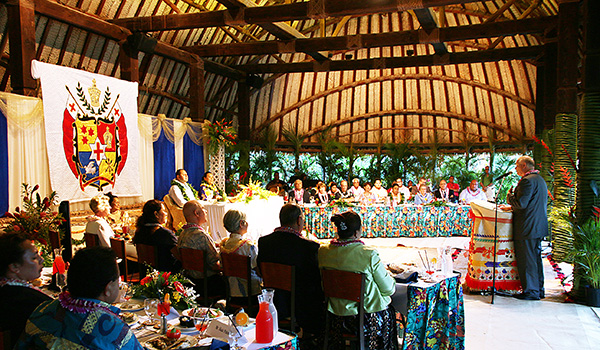
Elder Dale G. Renlund of the Twelve (right) addresses H.M. King Tupou VI (left, on the dais) and H.M. Queen Nanasipau’u (on his right).
Following dinner, Elder Renlund spoke of the importance of family and pointed out that his own “ties to Tonga” came through his mother-in-law, who had been born in Nuku’alofa, capital of the “Friendly Islands,” when her parents served a Latter-day Saint mission there, and that he had been required to learn to say the traditional Tongan greeting, Mālō e lelei, when he was courting his wife. He also spoke of the importance of families.
BYUH President Tanner also told the royal couple that approximately 130 Tongans comprised the largest group of Polynesian students at the university.
Moving on to PCC’s Pacific Theater, the king and queen were introduced to the Hā: Breath of Life evening show audience. As they did for the preceding banquet, PCC Physical Facilities staff had removed some of the seats from the lower-center-section to build a raised “throne,” where the royal couple enjoyed the production.
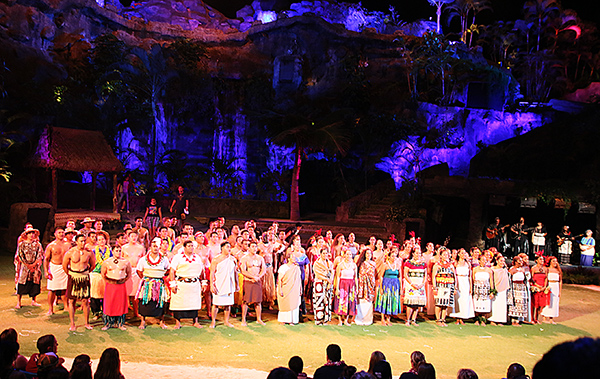
The cast of the PCC evening show, Ha: Breath of Life serenades the royal couple.
Day 2: The king and queen ‘reign’ over the reopening
Under beautiful skies the next morning, June 11, President Grace and his wife, Valerie, escorted the king and queen to the Tongan Village on a canoe. Disembarking, the royal couple walked along a ngatu (tapa or bark cloth)-covered path, passed under an arch decorated in their honor, and took their places on yet another raised, throne-like dais in front of the queen’s summer palace in the village.
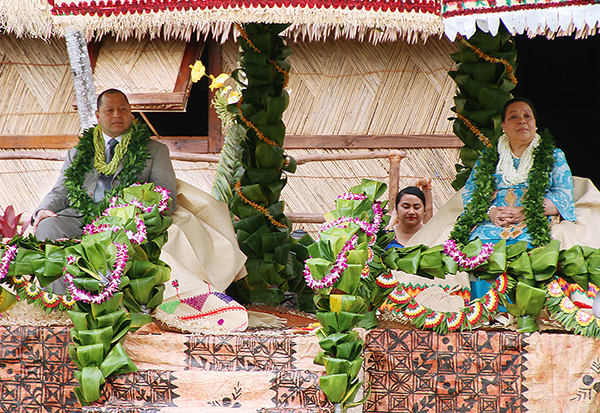
H.M. King Tupou VI (left) and H.M. Queen Nanasipau’u (right) “reign” over the grand reopening of the PCC’s recently renovated Tonga Village from a raised throne-like dais in front of the queen’s summer palace.
Following songs by the Kahuku 3rd Ward Latter-day Saint Tongan choir, a prayer, and the choir again singing the Tongan national anthem, Tongans from the Center, BYU–Hawaii and the community presented the royal couple with traditional gifts, including a large kava root, three very large whole-cooked pigs, other food, lengthy pieces of bark cloth, hand-woven mats, and more.
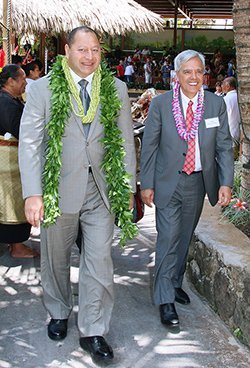
King Tupou VI (left) with Elder O. Vincent Haleck of the Seventy and First Counselor in the Auckland, New Zealand-based Area Presidency: Elder Haleck, who blessed the reopened Tongan Village, will become Pacific Area President in August.
“Here then in this beautiful Tongan village, we encapsulate all that is significant, worthy and meaningful to the Polynesian Cultural Center,” President Grace said. “It is a showplace for a magnificent culture. It is a place of growth and financial support for BYU–Hawaii students and community employees; and it is a place that will bless all who visit.”
Under assignment from the First Presidency and the Twelve of the Latter-day Saint Church, Elder Haleck blessed the newly renovated Tongan Village, blessing it to be “a place of many gatherings, a place where those who come here to visit, to see and witness the architecture and the buildings and the places where many of us whose ancestors have come to live and dwell in these places in the isles of the sea, particularly in Tonga, that they will come to appreciate those people who are here representing and reflecting the culture of Tonga.”
“I bless it that as many, many will come to this wonderful place that they will be touched in their hearts, that they will find tranquility, that they will indeed find a friendly people — friendly not only in their smiles, but more friendly in the richness of who they are in the cultures and the peoples that they represent,” he said.
In conclusion, Elder Haleck blessed the PCC’s Tongan Village that it would be a “wonderful place” where the students would gain “a sense of identity of who they are: Not only as people of the Pacific, particularly Tonga, but that they’ll understand their great identity as children of our Heavenly Father.”
The king responded: “It’s a great idea that our young people can get to help spread their own culture here, as well as the Center helping them to contribute toward their further discipline and education. It not only fosters pride in their own cultural identity, but also helps preserve and pass on the love of their own culture.”
He explained he and the queen had previously visited the PCC as tourists, but this was their first official visit. He said his father, the late King Taufa’ahau Tupou IV, paid several official visits, and other members of the royal family had also come over the years. In fact, the late Queen Salote III, the current king’s grandmother, authorized the addition of a quarter-scale replica of her fale fakatu’i or summer palace when labor missionaries were first building the PCC in the early 1960s and sent two skilled craftsmen to oversee its construction.
Along with “an enormous sense of pride” the king said he saw among the PCC workers, he also observed that “the PCC is a place to mature in character, where students can develop and gain strength in their own individual traits in a safe and guided environment. Character is what makes us what we are in the long run. It is what we become for the rest of our lives.” The king described such pride, character and discipline as “three mutually supporting building blocks.”
“Finally, I would like to thank the Center and Brigham Young University for providing an opportunity for education for so many of my fellow islanders for so many generations.”
Next, in keeping with Tongan custom, the Center had asked retired BYU–Hawaii and former PCC president Eric Shumway to sit opposite the Tongan Village green and interact in high oratorical Tongan with his majesty’s talking chief, Motu’apuaka, who sat on the ground near the king’s feet.
As a young Mormon missionary in Tonga, Shumway had developed such an unusual fluency in the Tongan language that he was asked and given permission to take the Tongan chiefly title Faivaola.
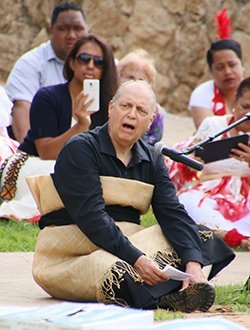
Retired BYUH/PCC president Eric “Faivaola” Shumway speaks on behalf of the Polynesian Cultural Center
Dressed in traditional Tongan clothes and after acknowledging the royals and all of the dignitaries, Shumway also “recognized all those whose hands and hearts led to the building of the Polynesian Cultural Center and our presence here today.”
He then traced the history of Laie as an ancient Hawaiian place of refuge and its church history starting with the purchase of Laie plantation in 1865, particularly pointing out that when Latter-day Saint President David O. McKay dedicated the site for the future BYU–Hawaii in 1955, in his blessing he said the town of Laie would become “a missionary factor influencing not thousands, not tens of thousands, but millions of people who will come seeking to know what this town and its significance are.”
Approximately 40 million visitors have come to this small community on the north shore of Oahu in the fifty-plus-years since then.
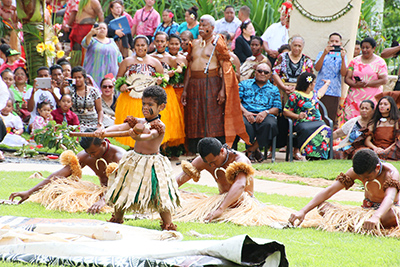
The 4-year-old grandson of the PCC’s first Fijian Village “chief” Ratu Isireli Racule, leads the villagers’ offerings on behalf of the current “chief”, Ratu Inoke Seru Suguturaga, who is one-quarter Tongan on his mother’s side and related to the queen.
At the end of the program, each of the PCC’s other villages — representing Hawaii, Tahiti, Aotearoa (Maori New Zealand), Samoa and Fiji — presented the king and queen with additional gifts, and sang and danced in their honor.
President Grace, on behalf of the PCC executive team and board of directors, also presented the royal couple with a large, hand-sewn Hawaiian quilt, and a large supply of chocolate-covered Hawaiian macadamia nuts to take home.
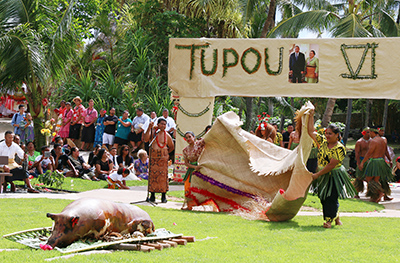
The Samoan villagers offer the king and queen another large, cooked pig, a fine mat and other traditional gifts.
Following a luncheon in the Hale Aloha for the royal couple and invited guests, Elder Tukuafu said, “I feel that the whole of Polynesia has come together to celebrate and honor the king, and I don’t think there is anything like this where he could travel to each nation and be greeted in a way like they have done here today. It was fantastic.”
“What we see here is only a small portion of what’s been done to further work, back in our own country and also abroad.”
And Elder Haleck added, “The circumstances couldn’t have been more favorable: I’m grateful for the blessings of Heavenly Father for providing beautiful weather for this day and this beautiful ceremony. We’ve all felt His spirit present here today.”
“We’re grateful for the surroundings we’re in, and we feel a special kinship to the students from the islands who are here going to school. We’re grateful for this wonderful place the Church has provided, the Polynesian Cultural Center, where we can celebrate our heritage and our cultures, and understand and remember who we are as a result.”
“I think the Polynesian Cultural Center is providing much more than an education; it’s speaking also to the people and reminding them of who they are.”
Day 3: An interdenominational Tongan musical program in Honolulu concludes the events
On Sunday afternoon, June 12, the action moved to the Latter-day Saint Tabernacle at the intersection of Beretania St. and Kalakaua Avenue in Honolulu, for an interdenominational pō hiva or evening musical “fireside” program. Choirs from the Kahuku 3rd Tongan Ward, the Kahuku Wesleyan Methodist Church and the Free Church of Tonga in Kalihi, a section of Honolulu, took turns filling the high-ceilinged acoustically-rich Tabernacle with magnificent music.
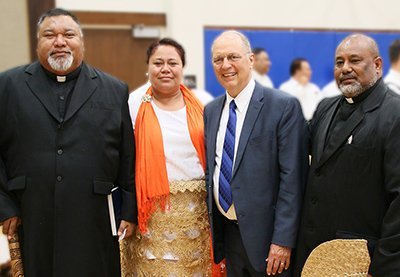
(Left – right): Rev. Noa Vaea of the Free Church of Tonga in Kalihi, his wife Moana Vaea; retired BYUH and PCC president Eric Shumway – who acted as the PCC’s talking chief on Saturday; and the Tongan church’s secretary, Samuela Tatofi at the final grand reopening function.
Shumway, who was also a former mission and temple president in Tonga, delivered the keynote speech — in Tongan, of course. His descriptions of learning the Tongan language many years ago, among other comments, obviously delighted those present.
And typical of all Polynesian events, particularly Tongan ones, heavy refreshments — including Tongan otai fruit-and-coconut-cream juice — followed in the auxiliary hall. Many lingered, chatting with family and friends, seemingly reluctant to bring this historical event to a close.
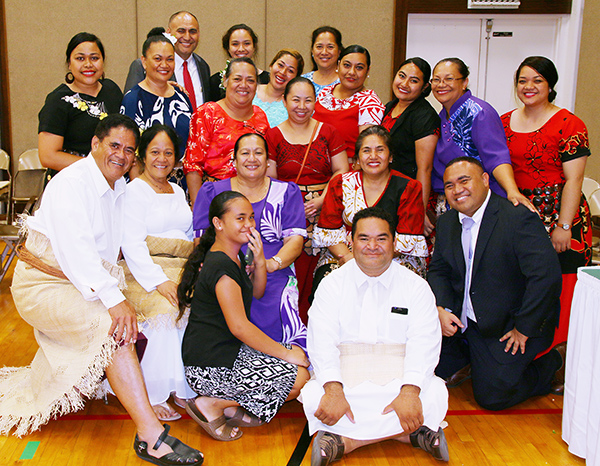
Some of the PCC team members and friends at the Sunday evening Program in the Honolulu Tabernacle.
Story and images by Mike Foley

Mike Foley, who has worked off-and-on
at the Polynesian Cultural Center since
1968, has been a full-time freelance
writer and digital media specialist since
2002, and had a long career in marketing
communications and PR before that. He
learned to speak fluent Samoan as a
Mormon missionary before moving to Laie
in 1967 — still does, and he has traveled
extensively over the years throughout
Polynesia and other Pacific islands. Foley
is mostly retired now, but continues to
contribute to various PCC and other media.

Great work Mike Foley!!